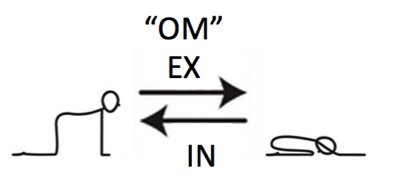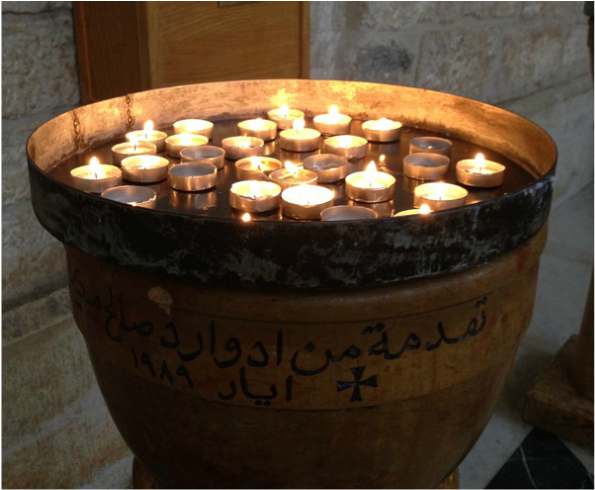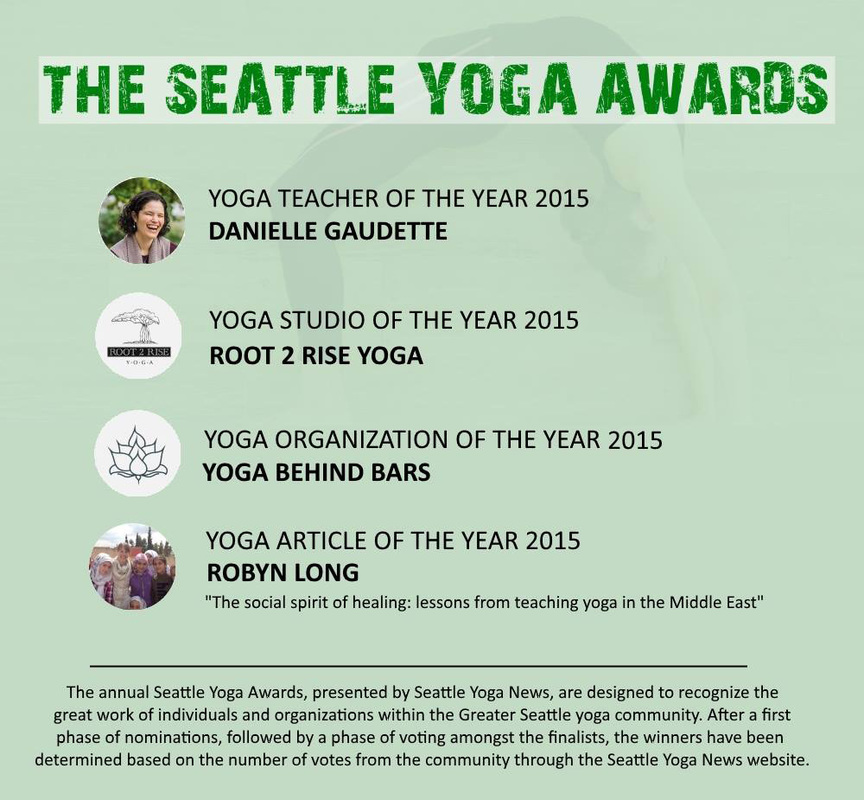|
Interested in incorporating mantras into your daily yoga practice? Bringing them into your asana practice is an excellent way to strengthen focus and deepen the benefits of yoga. Here are a few tips and an introduction exercise for beginners. What is a mantra? A mantra is a syllable, group of words, or phrases, which can be recited orally or silently. In Sanskrit, it is a term that combines two words: mananat (reflection) and trayate (protection). According to Yoga tradition, when we chant and reflect on a particular mantra we will see and experience the quality of that mantra, and thus we will be protected. For example, mantras that focus on the sun (e.g., sūrya) embody the qualities of light, energy, and radiance. Mantras focused on the moon (e.g., somena) evoke qualities that are cooling and nourishing. Chanting mantras before and during meditation has numerous benefits; it has subtle yet penetrating effects on both mind and body. Chanting, which creates vibrations in the throat, chest, abdomen, and jaw, has been found to stimulate vagal sensory afferents and promote relaxation [1]. Introducing mantra into your asana Using a mantra while practicing yoga postures (asana) is an excellent way to strengthen one’s focus, which in turn deepens one’s practice. Here are a few ways to include mantras in an asana practice:
An example of chanting “Om” on the exhalation in asana Starting with Om
Om is an powerful, yet simple mantra to begin using because it is a bija (seed) mantra. Bija mantras are one syllable and activate specific energy points to balance or purify the mind and body. Om is a sacred word that encompasses all other sounds in the universe. It is the primary sound from which all others emerged. While it is often written “Om”, a more accurate transliteration is “AUM” since there are three distinct sounds that blend together. The mantra represents four states of consciousness. A – is the conscious, or waking, state U– is the unconscious, or dream, state M – is the subconscious, or deep sleep, state There is a pause at the end of AUM, which represents the state of infinite consciousness How to pronounce Om Here are a few tips for pronunciation:
If you choose to chant out loud on the exhalation, the sound should come easily and comfortably. If you feel short of breath or any discomfort, alternate between orally and silently as you build up the breath capacity to chant out-loud. Here's how to try it today Chant Om when you exhale during any forward bending pose, such as Uttanasana (standing forward bend) or chakravakasna (as pictured above). Or during a gentle breathing practice at the end of your practice. The only hard-and-fast rule when chanting is to chant with joy and gratitude from the heart – so don’t hesitate to begin today! Stay tuned for more Monday Mantra tips and sign up for the monthly newsletter with more detailed suggestions for practice. 1. Brown, R.P., Gerbarg P. L. (2005). Yoga: A Breath of relief for Hurricane Katrina refugees. The Journal of Family Practice, Vol. 4, No. 10. http://www.jfponline.com/Pages.asp?AID=2736
0 Comments
This is the first #sevasaturday post –check out the past post discussing seva from Nov. 21, 2015.
Last spring I was fortunate to have had an opportunity to volunteer with a Syrian organization and offer yoga to Syrians who had sought safety in Turkey (here’s an article about the project). Back home in Seattle, I’ve explored ways to continue supporting Syrian communities. Friends and colleagues have asked for information on how they can help too. Here are a few ways that I’ve found to be active in supporting Syrians. 1. Donate funds to grassroots organizations promoting peace Several inspiring Syrian organizations are building a brighter future in their country by promoting civil society, human rights, and peace initiatives. Three great places to donate funds:
Winter is coming and refugee camps will be cold in Europe and the Middle East. Children need hats and sweaters to keep warm in the camps. Syrian women are also in need of reusable menstrual pads. A Seattle-based organization is coordinating the delivery of these items – see the post by the Salaam Cultural Museum. 3. Make your voice heard in supporting Syrian refugees Sadly, in the wake of the attacks in Paris, many politicians and individuals are attempting to block the resettlement of Syrian refugees in the U.S. This response is based in fear and collectively punishes people who are fleeing the same violent groups that carried out those attacks. Here are a few ways to promote compassion:
4. Be a volunteer in programs for Syrian refugees in your community The International Rescue Committee has offices and networks throughout the US that facilitate refugee resettlement. Check out their Volunteer Page to find opportunities to welcome Syrians locally. Google other local organizations in your community. For example, World Relief in Seattle is gathering supplies to furnish homes for refugees, recruit English tutors, and organize events. One of the aspects of yoga that I’m most drawn to is the concept of seva, a Sanskrit term that refers to selfless service. Seva is considered to be a core aspect of personal growth and transformation in the path of yoga. The ancient yoga gurus believed that practicing seva enables us to attain a deeper understanding of ourselves and, as a result, attain a higher level of consciousness.
Two pillars of seva are compassion and promoting collective wellbeing. There are dozens of ways that we can practice seva on a daily basis – everything from random acts of kindness to volunteering with a community organization, or spending quality time with your family. What is most important in selecting activities is that:
Anyone who has volunteered for a cause they are passionate about knows the power of giving your time and energy – it is inspiring, humbling, and often a lot of fun! To foster the exchange of ideas about practicing seva, I’m starting a series of #sevasaturday posts. Keep watch for ideas and share your seva activities to inspire more action. This article was originally published by Seattle Yoga News on November 16, 2015. A week of tragic events has reminded people around the world that life is incredibly fragile. Senseless acts of violence have stolen hundreds of lives across Paris, Beirut, Baghdad, Bethlehem, Jerusalem and Aleppo – the list of affected communities is long. As I reached out to friends in ensuring their loved ones were safe, my heart grew heavy as the news became increasingly tragic with each day. Then I remembered that yoga offers us a powerful framework for moving forward in the wake of tragedy – shraddha.
The concept of shraddha Shraddha is Sanskrit for faith, a trust, or certainty of confidence. The Yoga Sutra-s introduce the meaning of shraddha in the first chapter. Sutra 1.20 reads “sraddha virya smrti samadhiprajna purvakah itaresam”. My teacher T. K. V. Desikachar interprets this sutra as: “Through faith, which will give sufficient energy to achieve success against all odds, direction will be maintained. The realization of the goal of Yoga is a matter of time” [1]. Shraddha is the foundation of one’s yoga practice. It is not a religious concept or a blind faith in life, but instead an internal faith based on one’s life experiences. Mr. Desikachar describes it as an unshakable conviction and the “energy which will hold us on the right track” [2]. The origins of shraddha further elucidate the word’s meaning. It is derived from two words: “shradh”, which means “remembering our ancestors with gratitude”; and “dha”, which means “to hold” or “to sustain”. In yoga, cultivating shraddha is paying gratitude to those who passed away and honoring the knowledge that they shared [3]. This knowledge and our gratitude keeps us on the path of yoga. It sustains us through even the darkest of times, such as when we start to doubt ourselves or the world around us. Shraddha and recent tragedies Whether or not we have been personally affected by the recent attacks, the pain of others feels raw and our sense of security has been shaken. Fear has become a dominant reaction in many circles and across social media outlets. This fear is dangerous. It narrows our view of the world. For example, in light of current events, this fear may follow a trend of wrongly blaming Islam and followers of Islam. Practicing yoga implies that we approach the world from a place of clarity and love, not fear. We cannot practice or teach yoga from a place of fear. Fear paralyzes us from following the path of yoga, from having compassion with all beings, and from extending kindness into the world. Shraddha is the opposite of fear. It is faith in ourselves that we can rise above pervasive violence and widespread fear. It is a conviction that affirms our humanity with one another – regardless of where we live or what religion we may practice. As Mr. Desikachar explains, “Faith is the conviction that we have a force in our heart which will protect us in difficult times and helps us to see the positive aspects” [2]. Shraddha empowers us to connect with our inner strengths and the resilience needed for healing. Cultivating shraddha Yoga gives us an opportunity to cultivate a stronger sense of shraddha, which enables us to move through emotions so we don’t get stuck in cycles of negativity. Where does one find shraddha? In the heart, the place of our deepest awareness. Shraddha is a light within our hearts that casts away fear. As with all concepts in yoga, it starts within ourselves and extends to others. Fostering shraddha enables us to listen, speak, and act from the heart. How does one cultivate shraddha? By practicing yoga regularly. There is always an opportunity to cultivate shraddha – especially when we are working through emotions after violent events. Below are a few ideas for focusing on shraddha in the wake of tragedy.
Try one or all of the above ideas in a single practice – and share other ways that you bring faith and healing into your practice. The ancient yoga texts emphasize that we each have a greater consciousness that shines like a light inside our hearts. That light connects us with one another. Fear prevents that light from shining. Shraddha makes it an unstoppable force of love. In times of tragedy it is even more important that we focus on the light within, because, in the words of Martin Luther King, Jr., “Darkness cannot drive out darkness; only light can do that. Hate cannot drive out hate; only love can do that.” A simple practice to cultivate shraddha This practice uses the mantra “Om Shraddhaya Namah”. Om is the Sanskrit syllable that embodies all other sounds in the universe. Namah means to “to praise”. Thus, this mantra is giving praise to shraddha. 1. Sit in any comfortable position, such as in a chair with your feet flat on the ground. Or you can sit on a blanket on the ground. 2. Close your eyes or set your gaze on the ground in front of you. Take a few deep breaths in and out through your nose. 3. Place your hands over your heart, with the palms facing down and one hand over the other. 4. Inhale: Silently recite “Om” while you stretch your arms out to the sides, palms facing to the front. 5. Exhale: Softly say “Shraddhaya Namah” while you bring your hands back over your heart. You can also say the phrase silently. 6. Repeat steps four and five 8 – 12 times. 7. Rest your hands in your lap and let your breath flow at a natural pace. When you are ready, slowly open your eyes. References and Notes 1. Desikachar, T. K. V. (1999). The Heart of Yoga: Developing a Personal Practice. Published by Inner Traditions, 244 pages. 2. Desikachar, T. K. V. (2001). What are we seeking? Published by Krishnamacharya Yoga Mandiram, 176 pages. 3. There is a specific practice called “Shraaddha” in Hinduism that entails honoring ones parents after they pass away. In the Yoga Sutra-s, Shraddha is not linked with any religion but instead one’s beliefs and practices. |
It is a tremendous honor that my article on sharing yoga with Syrians won "Yoga Article of the Year" in Seattle Yoga News. Endless gratitude to everyone who was part of and supported this inspiring project.
Archives
July 2017
Categories
All
|






 RSS Feed
RSS Feed